Scania DC16 PDE. Industrial engine en-GB 2 823 990. Operator’s manual - part 3
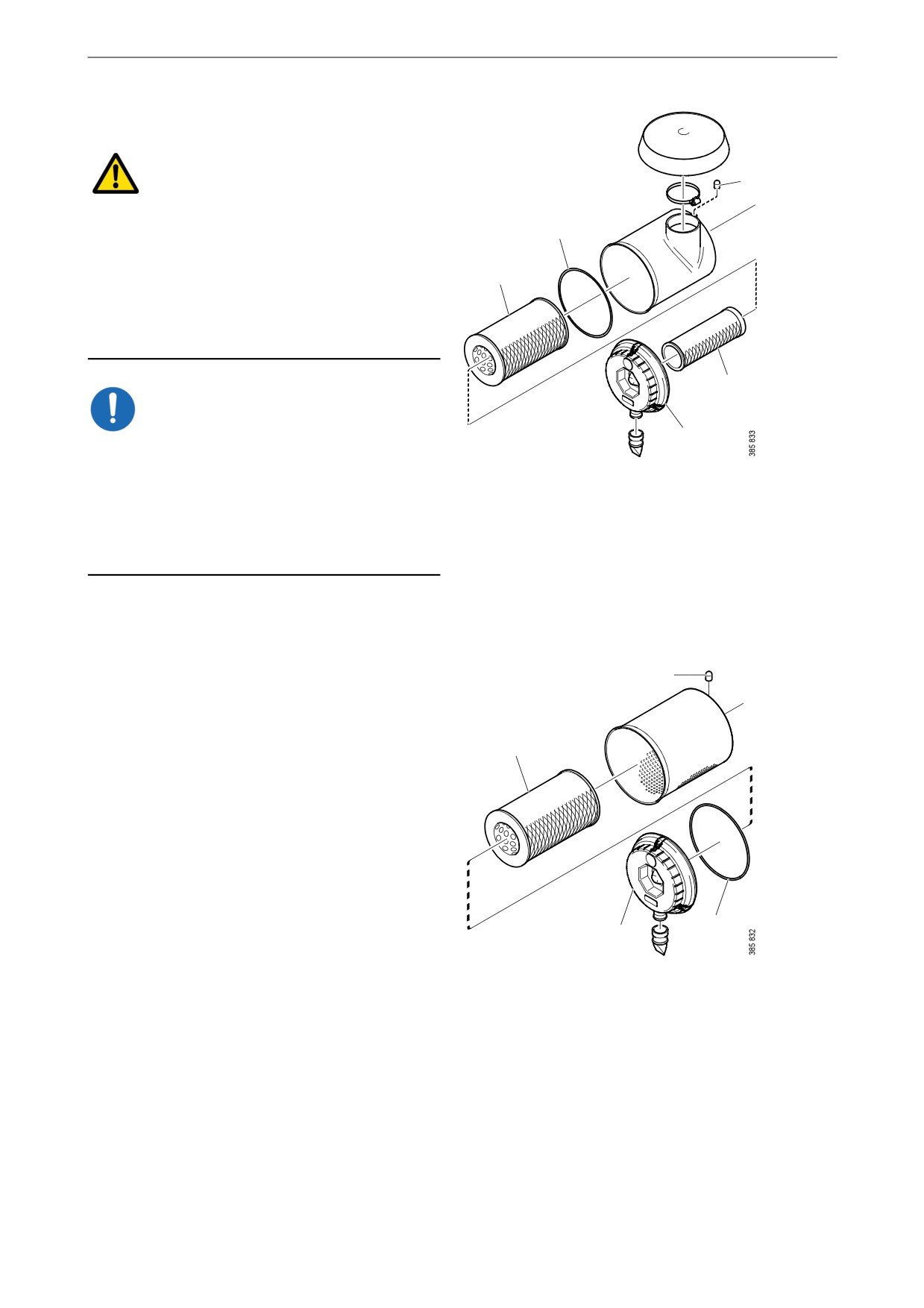
Air cleaner
Air cleaner
WARNING!
3
Never start the engine without the air filter in po-
sition. Without the air filter, there is a risk of dirt
2
being sucked into the engine.
1
The engine turbocharger will continue to rotate
and take in air for a time, even after the engine
has stopped. Therefore, wait for a few minutes
before opening the air cleaner.
4
IMPORTANT!
5
Renew the filter element earlier than the mainte-
nance interval if the vacuum indicator shows red.
1. Air cleaner with safety cartridge.
The filter element must not be cleaned in water
2. Filter element.
or be blown clean with compressed air. There is
3. O-ring.
always a risk that the filter element will be dam-
aged when it is cleaned.
4. Vacuum indicator.
5. Safety cartridge.
6. Cover.
2
1
Reading the vacuum indicator
If the vacuum indicator's red plunger is fully vis-
ible, renew the air cleaner filter element in ac-
3
4
cordance with the following section.
1. Air cleaner without safety cartridge.2. Filter ele-
ment.3. Vacuum indicator.4. O-ring.5. Cover.
32
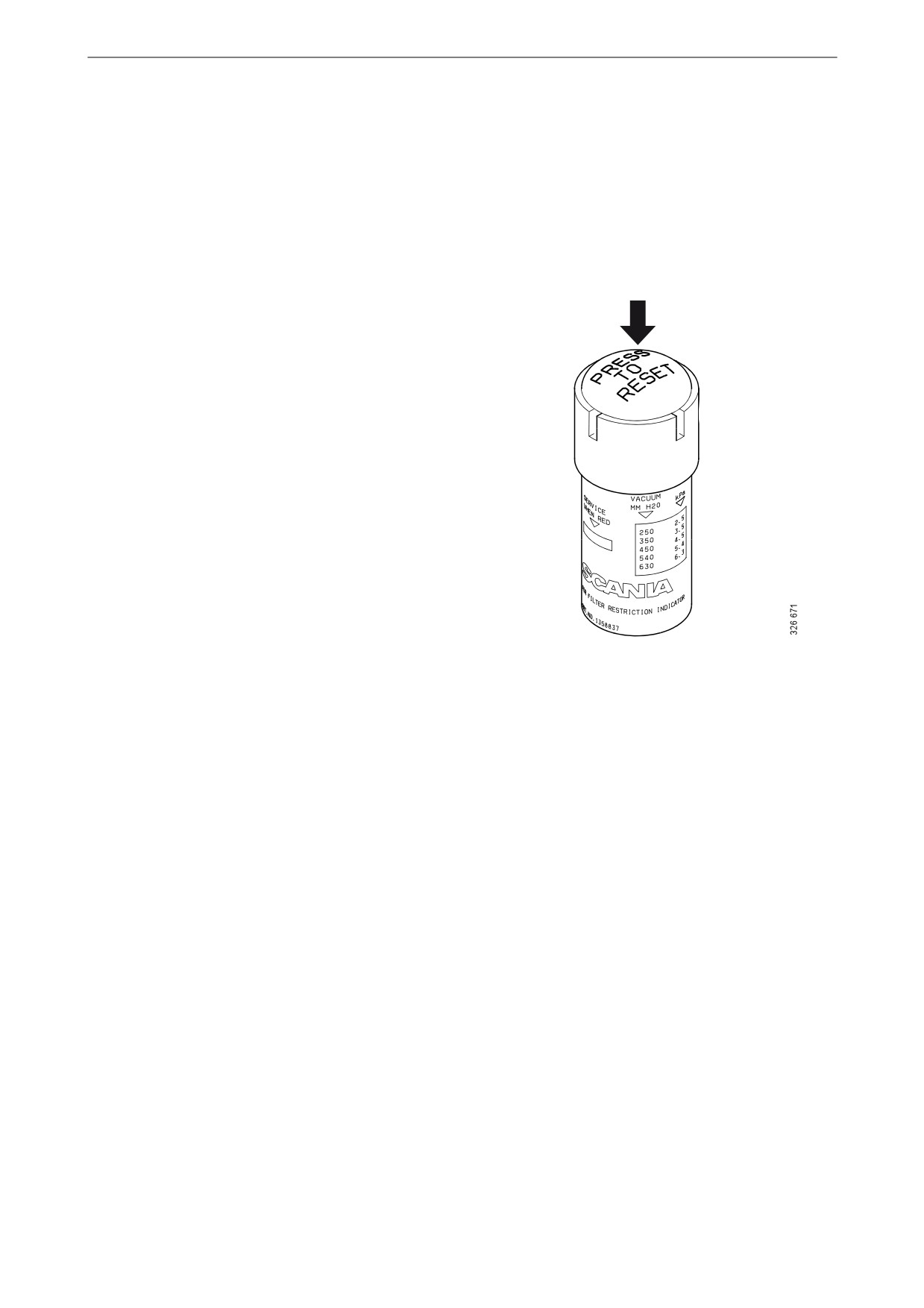
Air cleaner
Renewing the air cleaner filter
element and safety cartridge
1. Remove the cover from the air cleaner.
2. Renew the filter element.
3. If the air cleaner has a safety cartridge: Re-
move the safety cartridge and fit a new one.
4. Insert a torch into the filter element and
check that the filter paper is free of holes and
cracks.
5. Renew the O-ring if it is damaged or hard.
6. Assemble the air cleaner.
7. Ensure that the O-ring is not outside the edg-
es.
8. Reset the vacuum indicator by pressing in
the button marked in the illustration.
33
Cooling system
Warm climates
Cooling system
In order to retain the corrosion protection and the
higher boiling point, it is essential to use coolant
Coolant
consisting of water mixed with antifreeze and
Note:
corrosion inhibitor (ethylene glycol). This also
applies in countries where the temperature never
The coolant should be changed when the cooling
drops below 0°C (32°C).
system is cleaned: every 6,000 hours or at least
every five years. See Changing the coolant and
cleaning the cooling system.
The coolant recommended by Scania is a mix-
ture of water with antifreeze (ethylene glycol)
and corrosion protection. The coolant has several
characteristics which are important for the oper-
ation of the cooling system:
• Corrosion protection.
• Antifreeze.
• Increases the boiling point.
The coolant should always contain 35-55% by
volume of antifreeze and corrosion inhibitor so
that the coolant properties ensure that the coolant
works correctly.
Note:
Too high a dose of antifreeze and corrosion in-
hibitor will increase the amount of sludge and
blockages accumulating in the radiator. Too low
a concentration can lead to corrosion of the cool-
ing system and ice formation at low tempera-
tures.
34
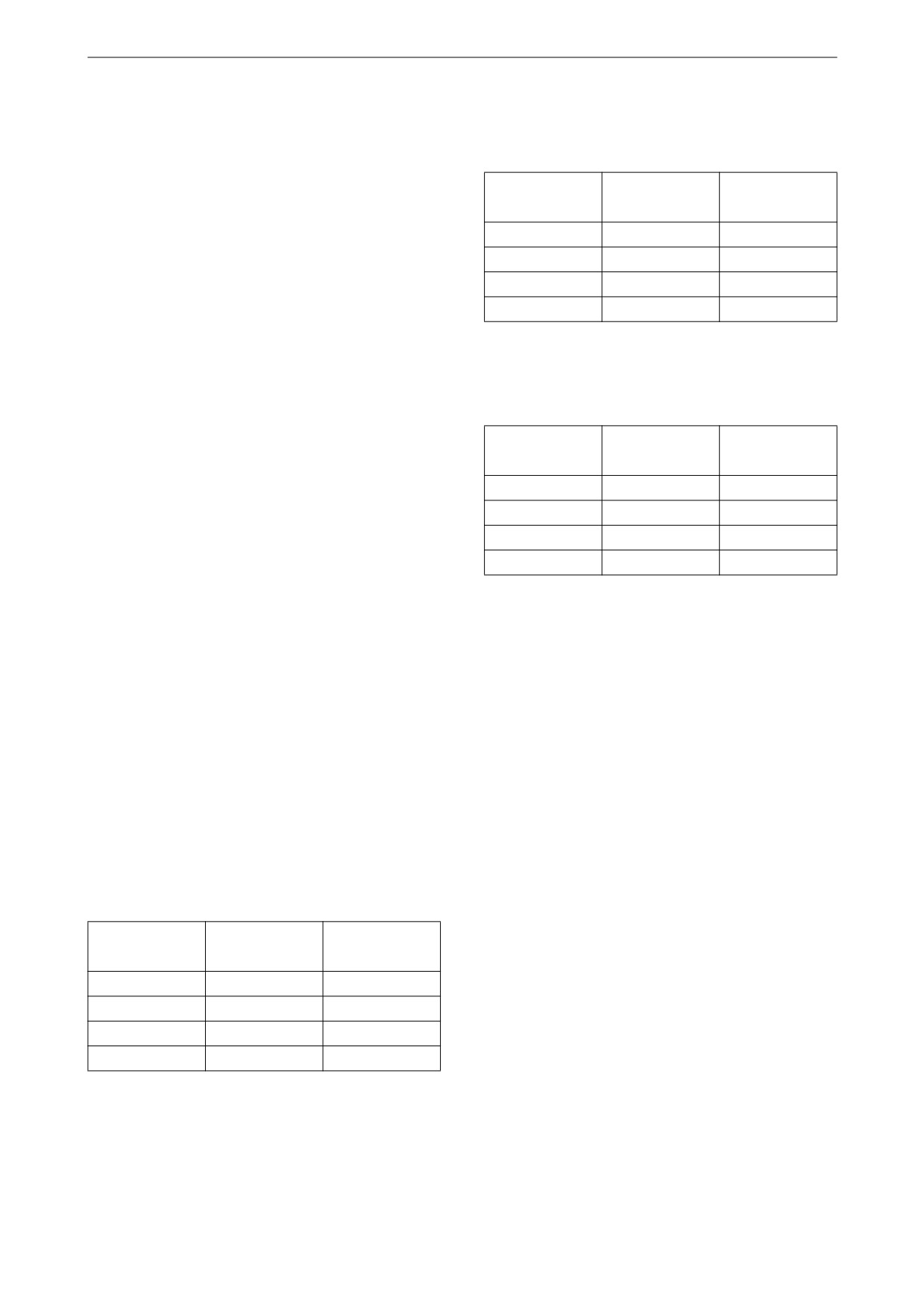
Cooling system
Antifreeze and corrosion protection
should be used in warm countries where there is
no risk of freezing in the cooling system.
The antifreeze and corrosion protection used in
Scania engines should be of the antifreeze (eth-
ylene glycol) and corrosion protection type.
Part no.
Volume
Volume
Only Scania coolant, or other products tested as
litres
US gallons
antifreeze and corrosion protection for Scania,
2 186 291
5
1.3
may be used in Scania engines. Products that do
2 186 292
20
5.3
not satisfy the requirements for use in a Scania
engine may cause faults in and damage to the
2 186 293
210
55
cooling system. This may lead to the invalidation
2 186 294
1,000
264
of Scania’s warranty for faults and damage
caused by the use of unsuitable coolant.
Scania concentrate
Scania Ready Mix coolant is a pre-mixed coolant
Scania also produces coolant with antifreeze and
consisting of water, antifreeze (ethylene glycol)
corrosion inhibitor in the form of a concentrate.
and corrosion protection. In warm markets
where there is no risk of freezing in the cooling
Part no.
Volume
Volume
system, the concentration of antifreeze and cor-
rosion protection can be lower than in Scania
litres
US gallons
Ready Mix 50/50. Scania Ready Mix 35/65 is
1
894
323
5
1.3
suitable for these markets.
1
894
324
20
5.3
Scania Ready Mix 35/65 contains 35% anti-
1
894
325
210
55
freeze (ethylene glycol) and corrosion protection
1
894
326
1,000
264
and 65% water.
Water
Use only pure fresh water that is free of particles,
sludge and other impurities. If there is uncertain-
ty about the quality of the water, Scania recom-
mends use of Scania ready-mixed coolants. See
the section Recommended Scania products.
Recommended Scania products
Scania Ready Mix 50/50
Scania Ready Mix 50/50 is a ready-mixed cool-
ant containing 50% antifreeze (ethylene glycol)
and corrosion protection and 50% water. It
should be used in cold countries where there is a
risk of freezing in the cooling system.
Part no.
Volume
Volume
litres
US gallons
1 921 955
5
1.3
1 921 956
20
5.3
1 921 957
210
55
1 896 695
1,000
264
Scania Ready Mix 35/65
Scania Ready Mix 35/65 is a ready-mixed cool-
ant containing 35% antifreeze (ethylene glycol)
and corrosion protection and 65% water. It
35
Cooling system
Topping up
Addition of antifreeze and corrosion
inhibitor to water
Coolant must only be topped up with pre-mixed
coolant. The pre-mixed coolant can either be
The coolant should contain 35-55% by volume
concentrate mixed with clean freshwater or pre-
antifreeze (ethylene glycol) and corrosion inhib-
mixed coolant from the factory. Use only pure
itor. The percentage varies depending on the
fresh water that is free of particles, sludge and
need for antifreeze.
other impurities.
A minimum of 35% by volume of Scania anti-
freeze and corrosion protection is needed to pro-
IMPORTANT!
vide sufficient protection against corrosion.
Measure the ethylene glycol content (antifreeze
Containers, which are used for mixing coolant,
and corrosion protection) with a refractometer
must be intended for the purpose and free from
following the instructions in the Checking the
any dirt or contaminants. When the containers
coolant's antifreeze and corrosion protection sec-
not in use they must be kept closed to avoid col-
tion.
lecting dirt and dust.
Risk of freezing
Note:
IMPORTANT!
Within the coolant change interval, coolant may
only be reused if it has been cleaned of dirt,
The engine should not be subjected to heavy
sludge and particles. If the coolant is contaminat-
loads if ice starts to form in the cooling system.
ed with oil or fuel, it must not be reused.
If the coolant starts to freeze, the water in the
coolant starts to crystallise and the ethylene gly-
col content in the coolant increases. If freezing
produces a great increase in the amount of ice,
circulation problems could arise. There is no risk
of damage by freezing if the content of Scania
antifreeze and corrosion inhibitor, or an equiva-
lent mixture of a similar product, is at least 35%
by volume.
Minimal ice formation in the coolant sometimes
causes minor problems without any risk of dam-
age. For example, the auxiliary heater may not
work for up to one hour after the engine has been
started.
36

Cooling system
Antifreeze and corrosion protection
concentration table, litres
Freezing point (°C)
-21
-24
-30
-38
-50
Cooling system volume
Ethylene glycol (vol. %)
35
40
45
50
60
(litres)
11
12
14
15
18
30
14
16
18
20
24
40
18
20
23
25
30
50
21
24
27
30
36
60
25
28
32
35
42
70
28
32
36
40
48
80
32
36
41
45
54
90
35
40
45
50
60
100
39
44
50
55
66
110
Ethylene glycol (litres)
42
48
54
60
72
120
46
52
59
65
78
130
49
56
63
70
84
140
53
60
68
75
90
150
56
64
72
80
96
160
60
68
77
85
102
170
63
72
81
90
108
180
67
76
86
95
114
190
70
80
90
100
120
200
37
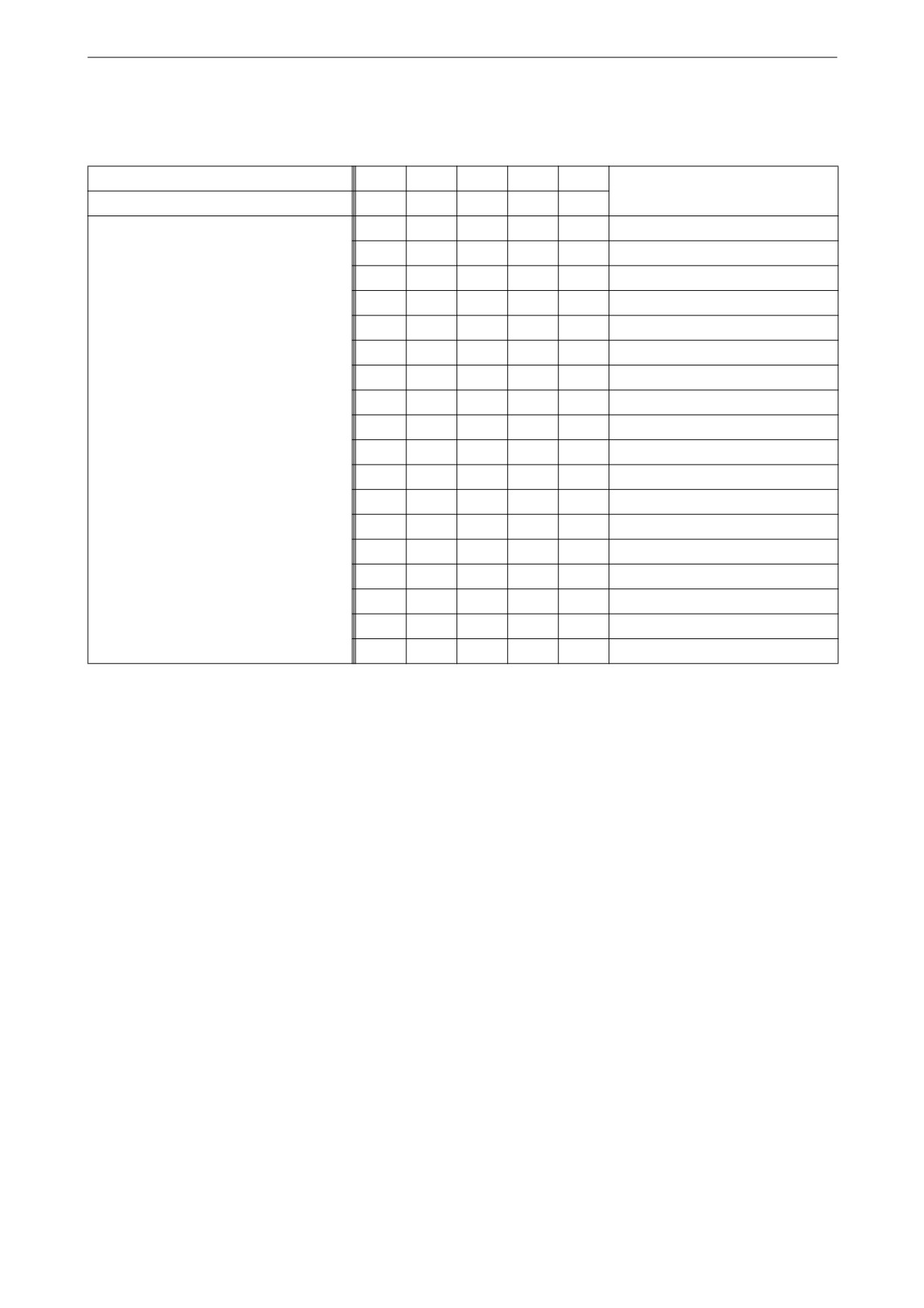
Cooling system
Antifreeze and corrosion protection
concentration table, US gallons
Freezing point (°F)
-6
-11
-22
-36
-58
Cooling system volume
Volume of ethylene glycol (%)
35
40
45
50
60
(US gallons)
2.9
3.2
3.7
4
4.8
7.9
3.7
4.2
4.8
5.3
6.3
10.6
4.8
5.3
6.1
6.6
7.9
13.2
5.5
6.3
7.1
7.9
9.5
15.9
6.6
7.4
8.5
9.2
11.1
18.5
7.4
8.5
9.5
10.6
12.7
21.1
8.5
9.5
10.8
11.9
14.3
23.8
9.2
10.6
11.9
13.2
15.9
26.4
Volume of ethylene glycol (US gal-
10.3
11.6
13.2
14.5
17.4
29.1
lons)
11.1
12.7
14.3
15.9
19
31.7
12.2
13.7
15.6
17.2
20.6
34.3
12.9
14.8
16.6
18.5
22.2
37
14
15.9
18
19.8
23.8
39.6
14.8
16.9
19
21.1
25.4
42.3
15.9
18
20.3
22.5
26.9
44.9
16.6
19
21.4
23.8
28.5
47.6
17.7
20.1
22.7
25.1
30.1
50.2
18.5
21.1
23.8
26.4
31.7
52.8
38
Cooling system
Checking coolant level
WARNING!
Do not open the coolant filler cap in the expan-
sion tank if the engine is hot. Hot coolant and
steam may spray out and cause burns.
If the cap has to be opened do it slowly to release
the pressure before removing the cap. Wear pro-
tective gloves as the coolant is still very hot.
IMPORTANT!
It is not permissible to top up large amounts of
coolant via the expansion tank. Filling via the ex-
pansion tank leads to air locks in the cooling sys-
tem which can lead to e.g. cavitation damage to
the coolant pump shaft seal. If a large amount of
coolant needs to be added, follow the instruc-
tions in the section Filling coolant.
Only pour pre-mixed coolant into the cooling
system.
The following instructions apply to Scania ex-
pansion tanks. For other types of expansion
tanks, follow the manufacturer's instructions.
1. Open the expansion tank cap and check the
coolant level.
- The right coolant level on a cold engine is
even with the lower edge of the filler neck.
- The right coolant level on a hot engine is
approximately 25 mm (1 in) over the low-
er edge of the filler neck.
2. Top up with coolant as necessary.
39
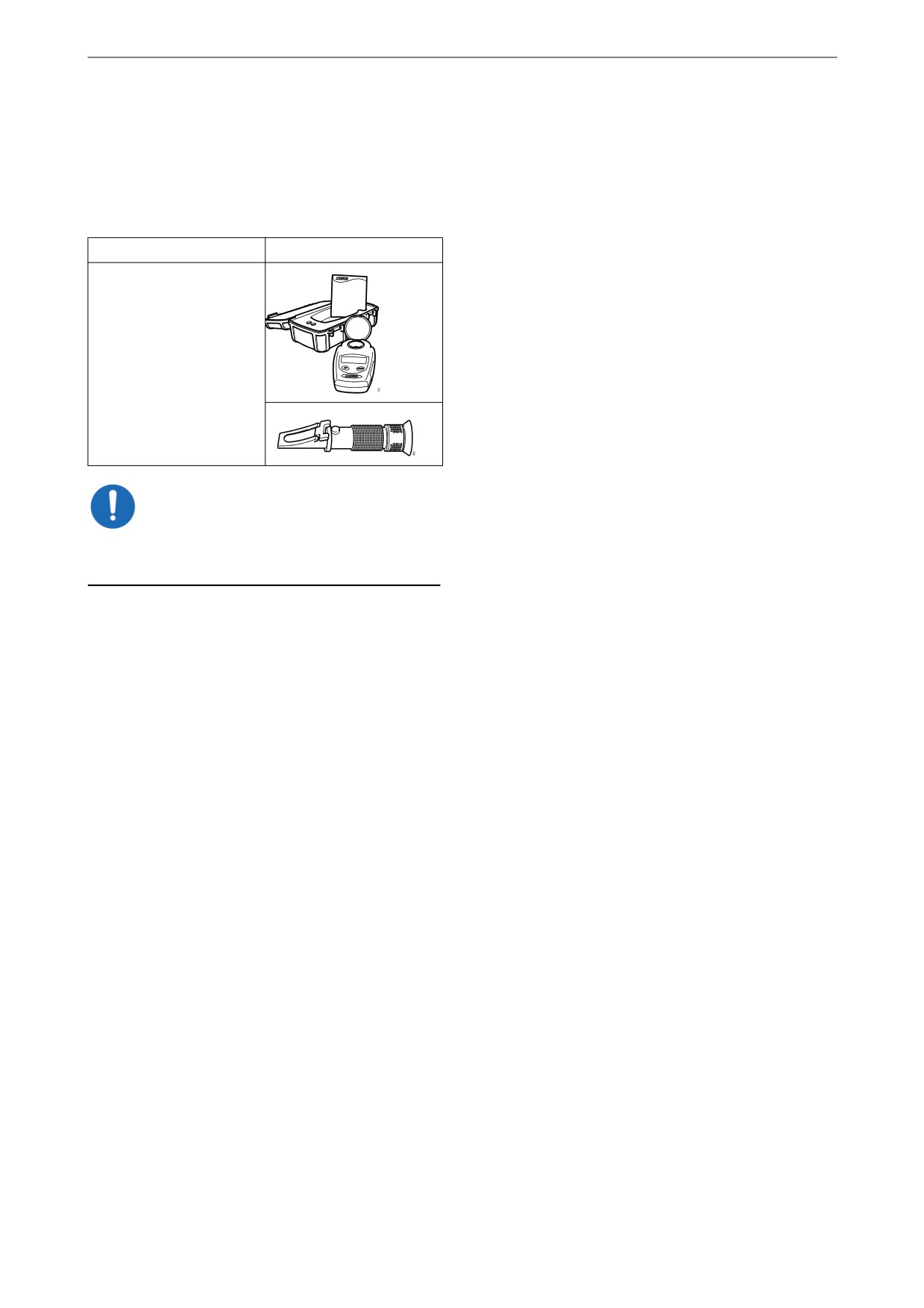
Cooling system
Checking the coolant's anti-
The following rules apply to ethylene glycol-
based coolant:
freeze and corrosion protec-
tion
• The antifreeze and corrosion inhibitor content
must be minimum 35 percent by volume for
Tools
corrosion protection to be sufficient.
• An antifreeze and corrosion protection con-
Designation
Illustration
tent greater than 55 per cent by volume im-
pairs the ability to protect against frost.
Refractometer
• If ice forms in the coolant, there are disrup-
tions initially, but there is no immediate risk
of damage. The engine should not be subject-
ed to heavy loads if ice starts to form.
IMPORTANT!
Use only pure fresh water that is free of particles,
sludge and other impurities.
1. Pour a small amount of coolant into a con-
tainer and check that the coolant is pure and
clear.
2. Change the coolant if it is contaminated or
cloudy.
3. Measure the antifreeze content with a refrac-
tometer.
40
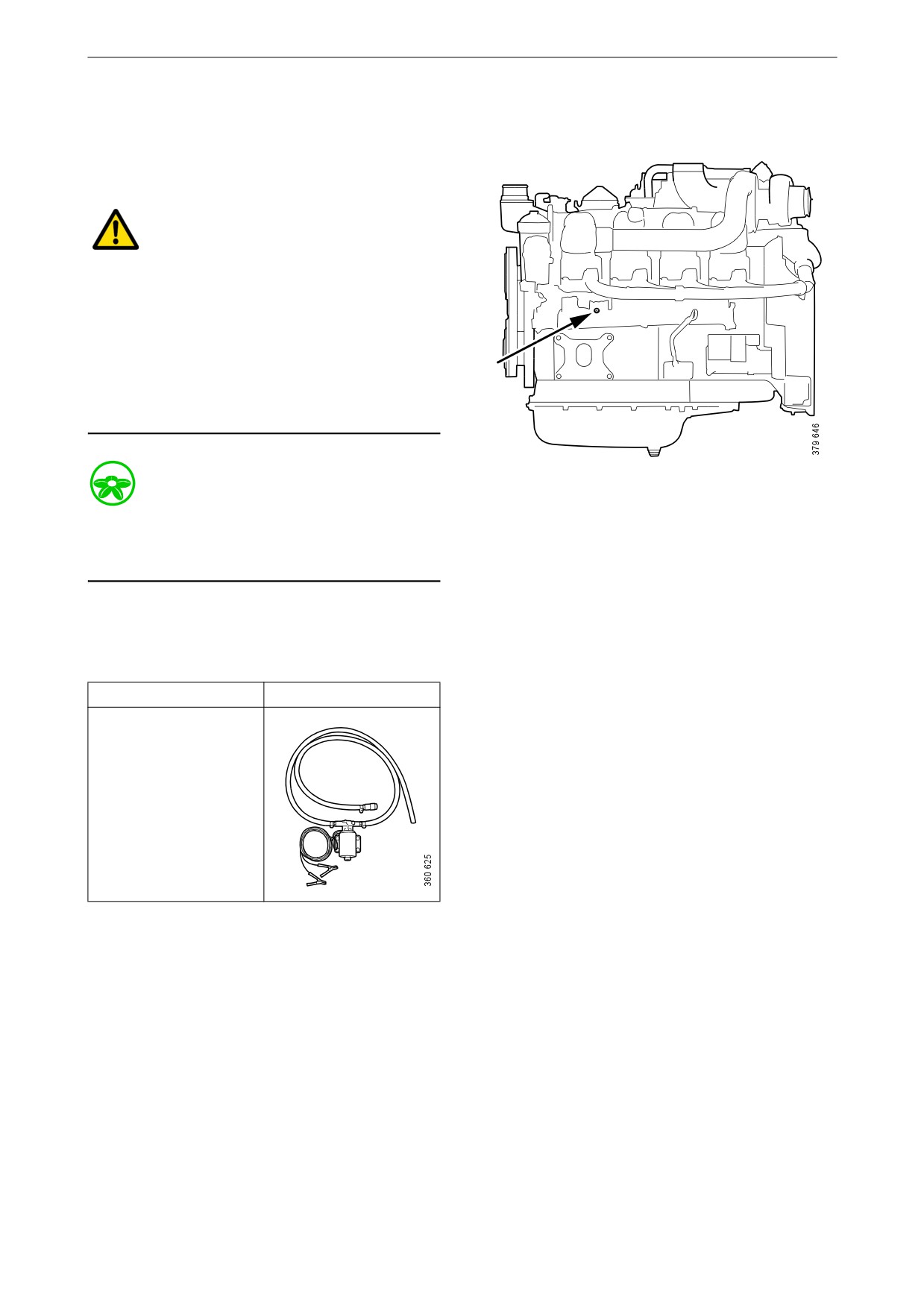
Cooling system
Changing the coolant and
3. Connect the pump to the draining nipple in
the cylinder block. See illustration.
cleaning the cooling system
Draining coolant
WARNING!
Do not open the coolant filler cap in the expan-
sion tank if the engine is hot. Hot coolant and
steam may spray out and cause burns. If the cap
has to be opened do it slowly to release the pres-
sure before removing the cap.
Use protective gloves as coolant can cause irrita-
tion if it comes in contact with the skin. Hot cool-
ant can also cause scalding.
4. Connect the pump’s two cable terminals to
Environment
the battery’s negative and positive terminals.
Make sure that the drainage starts. If the
Use a suitable container. Used coolant must be
drainage does not start: Change the position
disposed of as specified in national and interna-
of the cable terminals.
tional laws and regulations.
Repeat the procedure at the cooling system's
5.
lowest drainage point. The location of the
lowest drainage point on the engine may dif-
Draining coolant with coolant pump
fer depending on engine application.
Special tool
Number, designation
Illustration
2 443 679, coolant
pump
1. Open the expansion tank cap.
2. Position the hose from the coolant pump in
an empty container.
41
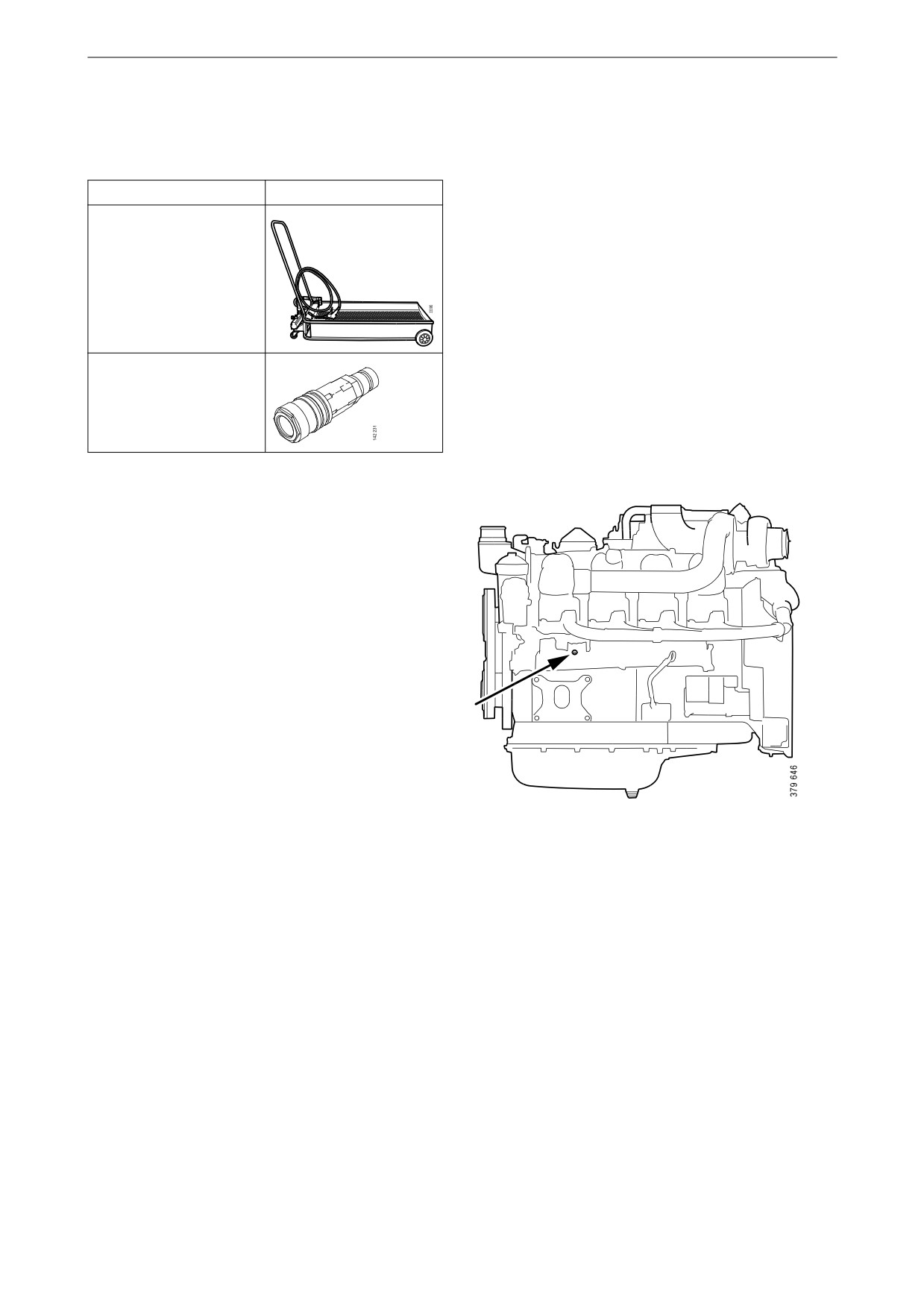
Cooling system
Draining coolant with coolant trolley
Tools
Designation
Illustration
588 540 Coolant trolley
99 301 Adapter
1. Open the expansion tank cap.
2. Position the hose from the coolant trolley in
an empty container.
3. Connect the trolley to the draining nipple in
the cylinder block. See illustration. The
adapter must be used when using the trolley.
4. Drain the coolant.
5. Repeat the procedure at the cooling system's
lowest drainage point. The location of the
lowest drainage point on the engine may dif-
fer depending on engine application.
42
Cooling system
Cleaning the cooling system
Note:
Clean the cooling system more often than speci-
fied in the maintenance interval if necessary.
External: Cleaning the radiator and
charge air cooler
IMPORTANT!
Do not use caustic soda or other alkaline deter-
gent as this could damage the aluminium.
Read the warning text on the detergent packag-
ing.
1. Check that the radiator and the charge air
cooler are not clogged on the air side and that
the cooling fins are not damaged.
2. Carefully scrape away any deposits from the
radiator cooling fins. Use a paraffin-based
engine cleaner if necessary.
3. Carefully straighten bent cooling fins using a
steel brush or the like.
43
Cooling system
Internal: Removing oil and grease
3. Fill the cooling system with clean hot water
mixed with detergent 2 479 017. Detergent
2 479 017 must make up 5-10% (depending
Environment
on the degree of dirt) of the total coolant vol-
ume.
Use a suitable container. Used coolant must be
disposed of as specified in national and interna-
If detergent 2 479 017 is not available, use a
tional laws and regulations.
dishwasher detergent for household dish-
washers that does not foam. Concentration
1%.
Always fit a new thermostat and a new cover to
4. Run the engine until it has reached operating
the expansion tank after cleaning, as the oil in the
temperature for approximately 20-30 min-
cooling system destroys the seals. If the engine is
utes. Remember to switch on the cab heating
equipped with a coolant filter, also renew this fil-
system, if one is installed.
ter.
5. Drain the cooling system.
It may be necessary to wash it multiple times if
6. Fill the cooling system with clean, hot water
the cooling system is very dirty. One cause of
and run the engine for about 20-30 minutes.
contamination can be that oil is lying on top of
7. Repeat steps 3-6 if the cooling system is not
the coolant and collecting high up in the cooling
clean.
system. If several rinses are needed, this is not
necessarily because work has been carried out
8. Drain the water from the cooling system.
incorrectly. Oil residues often need to be rinsed
9. If necessary, clean the expansion tank by de-
repeatedly from the expansion tank and the ex-
taching all hoses and rinsing and cleaning
ternal heating system to be completely clean.
with a degreasing agent and a dishwashing
brush.
Repeated washing is more effective and prefera-
ble to using higher concentrations of detergent
Alternatively, dismantle the expansion tank
(max. 10%) or cleaning for a longer period (max
and clean it with water with 10% of detergent
30 minutes).
2 479 017. Fill the expansion tank with the
mixture, shake it and drain it. Renew the cov-
If only a small amount of dirt has collected in the
er of the expansion tank.
expansion tank after cleaning, one extra rinse
10. Refit the thermostats.
and clean of the expansion tank only is usually
sufficient. There is no need to clean the whole
11. Fill the cooling system with new coolant as
cooling system again.
described in the next section.
12. Check again whether further dirt or oil has
1. Run the engine until it has reached operating
collected in the expansion tank. Decide
temperature and then drain the cooling sys-
whether it it is necessary to carry out another
tem following the previous description.
full cleaning or whether only rinsing or
2. Remove the thermostats.
cleaning of the expansion tank will suffice.
44
Cooling system
Internal: Removing deposits
Filling coolant
These procedures apply when the cooling system
Environment
has been drained and needs to be filled with a
large amount of coolant.
Use a suitable container. Used coolant must be
disposed of as specified in national and interna-
WARNING!
tional laws and regulations.
Use protective gloves as coolant can cause irrita-
1. Run the engine until it has reached operating
tion if it comes in contact with the skin. Hot cool-
temperature and then drain the cooling sys-
ant can also cause scalding.
tem following the previous description.
2. Remove the thermostats.
3. Fill the cooling system with clean, hot water
IMPORTANT!
mixed with radiator detergent which is based
on sulphamic acid and contains dispersing
Mix the coolant as specified in the section head-
agents. Follow the manufacturer's instruc-
ed Coolant.
tions for the concentration and cleaning peri-
Never fill a large amount of cold coolant in a hot
od.
engine. There is great risk of cracks forming in
4. Run the engine for the specified time. Re-
the cylinder block and cylinder heads.
member to switch on the cab heating system,
if one is installed.
Do not start the engine until the correct coolant
level has been obtained. If the engine is started
5. Drain the cooling system.
with an insufficient coolant level, it can damage
6. Fill the cooling system with clean, hot water
the coolant pump shaft seal, which leads to cool-
and run the engine for about 20-30 minutes.
ant leakage.
7. Drain the water from the cooling system.
8. Refit the thermostats.
9. Fill the cooling system with new coolant as
described in the next section.
45

Cooling system
Filling coolant with coolant pump
Special tool
Number, designation
Illustration
2 443 679, coolant
pump
1. Open the expansion tank cap.
2. Connect the coolant pump to the filler nipple
in the cylinder block. See illustration.
3. Connect the pump's 2 cable terminals to the
battery's negative and positive terminal.
Make sure that the filling starts. If the filling
does not start: Change the position of the ca-
ble terminals.
4. Start the engine and run it at idling for
15 minutes.
IMPORTANT!
It is very important that the engine is idling. En-
gine overspeed could damage the coolant pump
shaft seal, which leads to coolant leakage.
5. Switch off the engine and fill with coolant to
the maximum level through the expansion
tank.
Air pockets may still be left in the cooling sys-
tem. These will disappear after the engine has
been operated for a period of time. Therefore, the
coolant may need topping up at a later stage.
46
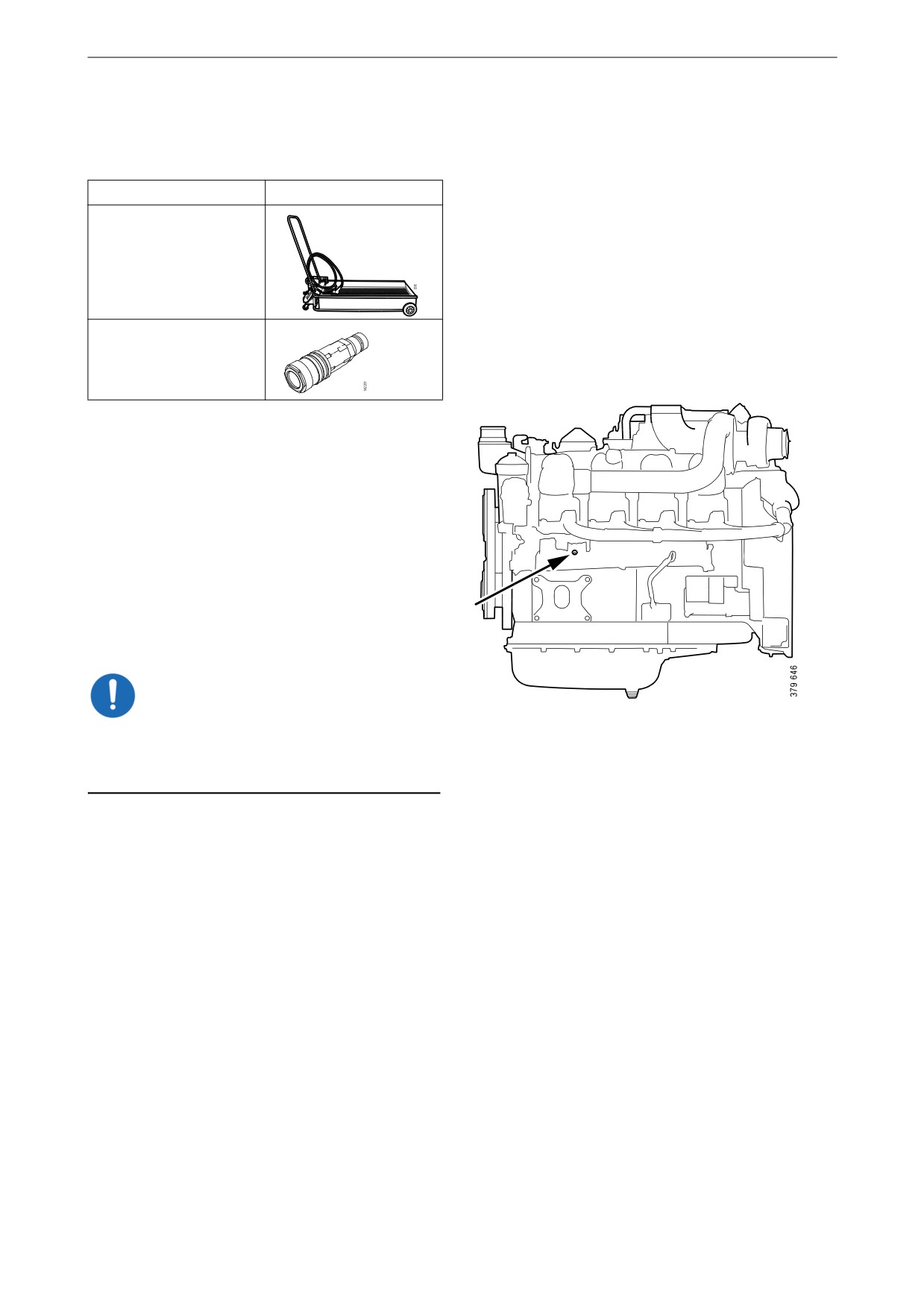
Cooling system
Refilling coolant with coolant trolley
Tools
Designation
Illustration
588 540 Coolant trolley
99 301 Adapter
1. Open the expansion tank cap.
2. Connect the coolant trolley to the filler nip-
ple in the cylinder block. See illustration.
The adapter must be used when using the
trolley.
3. Fill with coolant using coolant trolley to
pump up to the maximum level of the expan-
sion tank.
4. Disconnect the coolant trolley.
5. Start the engine and run it at idling for
15 minutes.
IMPORTANT!
It is very important that the engine is idling. En-
gine overspeed could damage the coolant pump
shaft seal, which leads to coolant leakage.
6. Switch off the engine and fill with coolant to
the maximum level through the expansion
tank.
Air pockets may still be left in the cooling sys-
tem. These will disappear after the engine has
been operated for a period of time. Therefore, the
coolant may need topping up at a later stage.
After filling, it may be good to start the engine
and check that no coolant leakage occurs.
47